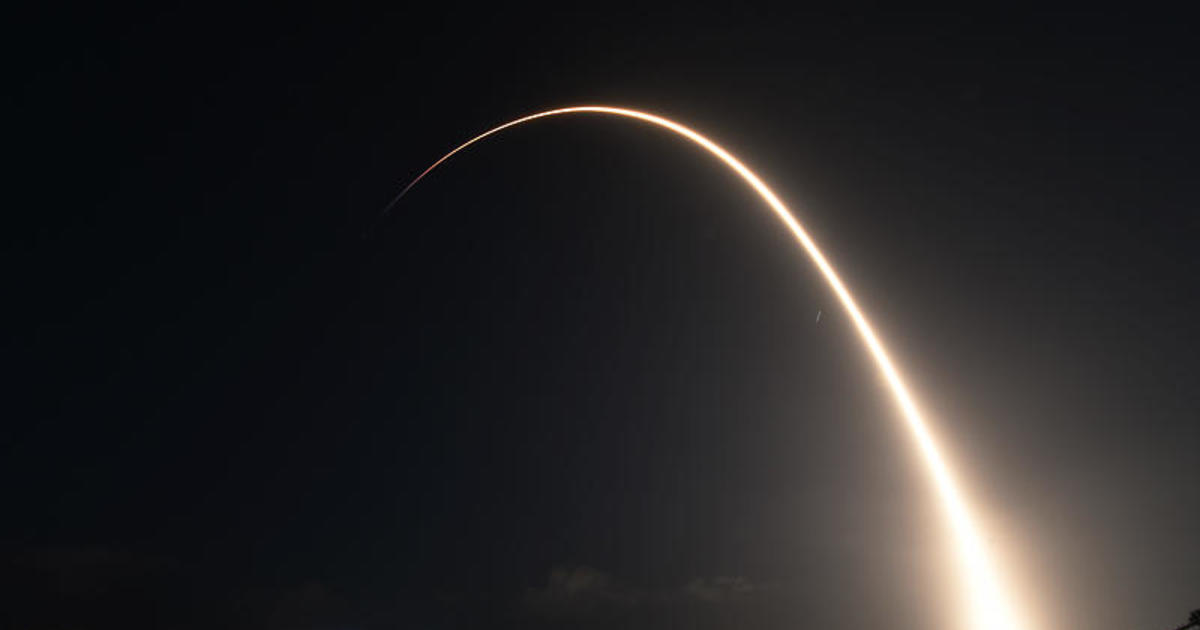Recovering from a last-second October 2 launch abort, SpaceX successfully fired off the same Falcon 9 rocket Thursday night, boosting a third-generation Global Positioning System navigation satellite into orbit for the U.S. Space Force.
The nine Merlin 1D engines in the rocket’s first stage, including two replacement engines, roared to life at 6:24 p.m. ET, pushing the slender 229-foot-tall Falcon 9 away from pad 40 at the Cape Canaveral Air Force Station atop a brilliant jet of flaming exhaust.
The engines appeared to operate flawlessly as the rocket climbed out of the thick lower atmosphere, putting on a spectacular evening sky show as it raced past a rising Mars and lined up on a northeasterly trajectory paralleling the East Coast.
A SpaceX Falcon 9 rocket, grounded by engine problems last month, roars away from Cape Canaveral Thursday, boosting a third-generation Global Positioning System navigation satellite into orbit for the U.S. Space Force.
William Harwood/CBS News
The engines shut down as planned 2½ minutes after liftoff. The first stage then fell away and headed for a successful landing on a off-shore droneship while the flight continued on the power of the Falcon 9’s single second stage engine.
The GPS-3 satellite — the fourth in a series of more powerful third-generation navigation stations built by Lockheed Martin — was expected to be deployed about a 90 minutes after liftoff. Assuming tests and checkout go well, it will join a globe-spanning constellation of 31 GPS satellites.
Orbiting in multiple planes, at least four GPS satellites are above the horizon as viewed from any point on Earth, broadcasting ultra-precise atomic clock signals allowing military and civilian receivers to compute a user’s precise position, altitude and velocity.
“GPS-3 provides three times greater accuracy and up to eight times improved anti-jamming power over satellites in the existing constellation,” Tonya Ladwig, acting vice president of Lockheed Martin’s Navigation Systems Division, told reporters in a recent teleconference. “For those keeping score, the four more powerful GPS-3 satellites will represent a little better than 12% of the 31 satellites in the constellation, but the number’s growing.”
Lockheed is building 10 GPS Block 3 satellites at an average cost of $529 million each. The company also holds a contract valued at up to $7.2 billion for up to 22 even more sophisticated GPS “Follow On” satellites.
An artist’s impression of a GPS-3 navigation satellite in orbit.
Lockheed Martin
An attempt to launch the latest GPS on Oct. 2 ended two seconds before the planned liftoff when the Falcon 9’s flight computer detected unusual pressures in the first stage turbopumps of two engines.
A detailed analysis revealed small vent lines were obstructed by a lacquer-like material used during the machinery’s fabrication that had not been cleaned off as expected. A fleet-wide inspection revealed similar issues in a handful of other engines slated for upcoming flights, including two high-priority NASA missions.
The suspect engines in the GPS rocket were replaced — the other seven were inspected and given clean bills of health — and all nine were successfully test fired at the pad on Saturday.
NASA plans to launch four astronauts to the International Space Station on November 14 aboard a SpaceX Crew Dragon ferry ship. The mission is the first operational Crew Dragon flight following a successful piloted test flight earlier this year.
Two of the engines in the first stage of the Falcon 9 earmarked for the “Crew-1” flight also had to be replaced following the GPS abort. Assuming data analysis confirms good engine performance Thursday, NASA should be able to press ahead with the long-awaited Crew-1 launch as planned.
